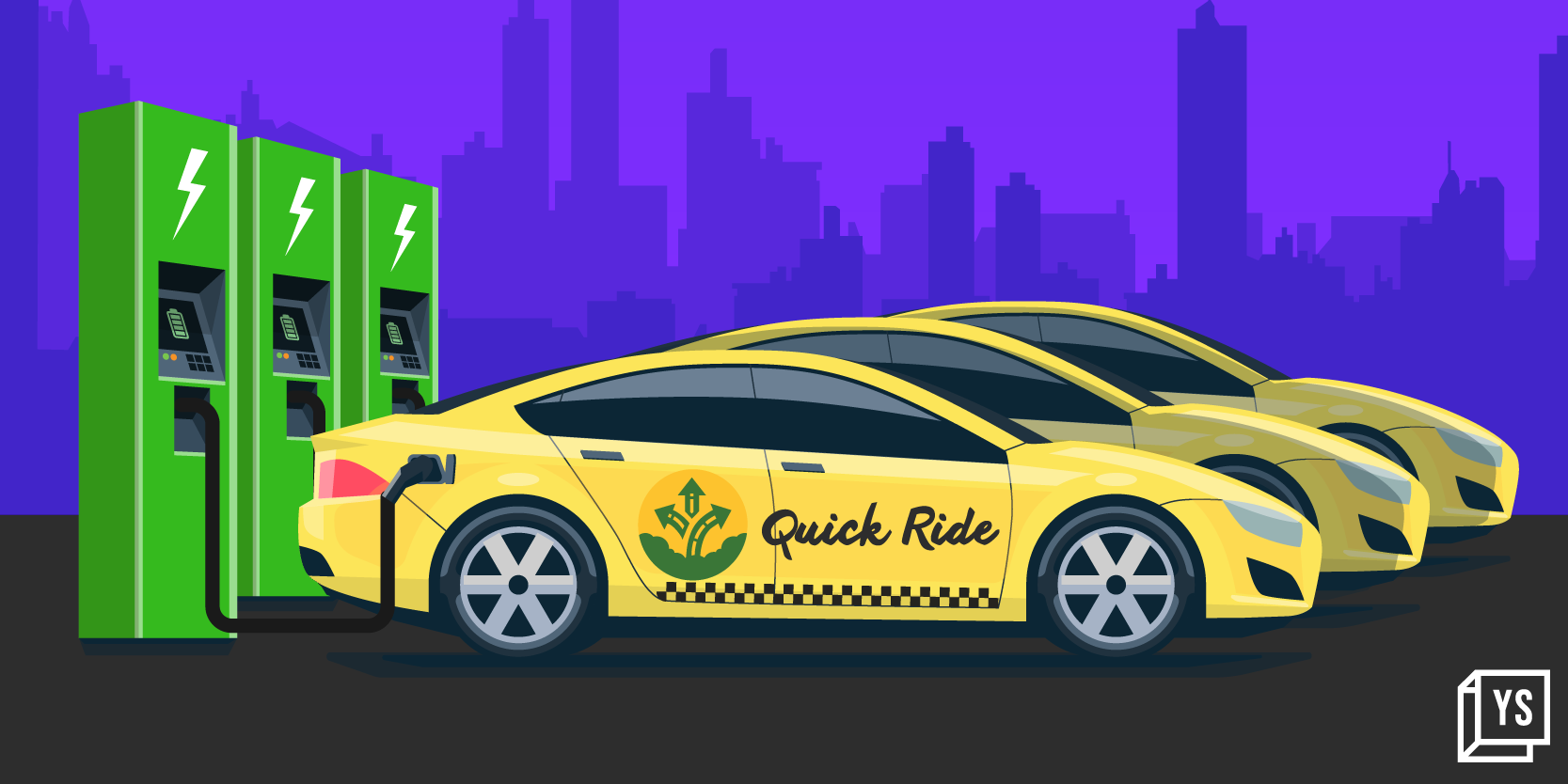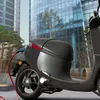Quick Ride bets on EV fleet to drive profitability, while carpooling, ICE biz find break-even lane
Quick Ride was founded in 2015 by KNM Rao, who has decades of experience at Cisco and Huawei under his belt. The company has raised funding from Naspers, Venture Highway, and Sequoia, although the latter have exited the firm.
Over the last five years or so, it’s been a bit of a bumpy, twisty road for .
The Bengaluru company started as a carpooling service in 2015, where its app matched individuals with drivers travelling in the same direction. Its philosophy was noble—reduce the number of cars on the road by getting people to carpool.
But, several reasons, including a lack of clear regulatory guidelines around carpooling in India, precluded the company from seeing meaningful revenue from the business, triggering a series of gambles that saw Quick Ride acquiring vehicles to offer airport rides, start a fleet operation to provide employee commute services, and then listing parts of this fleet on other ride-hailing platforms.
To those on the outside, it seemed the company was floundering. “The many pivots, although may have been necessary, were concerning. The startup wants to do everything, all at once, and that makes us wonder if they have a clear goal in sight,” says an investor who has followed the company’s developments closely.
However, several others placed their faith in KNM Rao’s vision—a fact underscored by the nearly $16 million the founder and CEO successfully raised over two rounds.
However, during the pandemic, Sequoia, one of Quick Ride’s marquee investors on whom the company had pinned its future funding hopes on, exited the company after taking a 50% haircut, although COVID-19 was not a factor in the decision. It also lost a lot of the momentum it had meticulously built on its carpooling platform over the years.
As of today, the company still hasn’t been able to recover to the level of engagement it saw on its carpooling app pre-COVID-19.
Despite being written off, Quick Ride’s story isn’t one of a series of missteps.
With India’s electric vehicle (EV) landscape reaching a fever pitch, Quick Ride is now betting on a surge in both individuals and companies shifting gears to EVs—be it for environmental concerns, long-term cost savings, or switching to sustainable means of transportation.
Last October, the company started piloting its EV fleet, and it has since expanded its fleet size to 200 vehicles in Bengaluru. Its non-EV businesses—carpooling and ICE fleet operations—hit breakeven in March 2023.
Multiple applications
Drawing from his experience of operating an internal combustion engine (ICE) fleet across various platforms, Rao is convinced that casting a wider net for his EV fleet is the path to follow.
So far, Quick Ride has listed its EV fleet on the company’s taxi app as well as platforms like MyGate, MakeMyTrip, ApnaComplex, and NoBrokerHood.
In fact, several Bengaluru-based IT companies have approached the company to explore the possibility of deploying its EV cabs for employee commutes. “We expect to finalise the IT partnerships in the next two months,” Rao tells YourStory.
Further, it is exploring listing its cabs in the premium EV category on ride-sharing platforms Ola and Uber.

(Design credit: Nihar Apte)
Already, Quick Ride’s EV ‘dart’ seems to be hitting the bullseye, for Rao says the EV business has achieved positive unit economics.
Every car earns the company around Rs 1.2 lakh per month in revenue. The profit margin, factoring in depreciation, is around 20%, meaning the entire EV business is essentially netting the company a handsome profit.
In fact, the company’s EV fleet management dashboard showed that several of its Tata Xpres-T cars—purchased in November last year—have already generated revenue surpassing Rs 14 lakh, higher than the car’s on-road price of around Rs 13 lakh.
“EV is going to be a big business for us. We want to scale to 500 vehicles by the end of the current financial year and 1,000 by the end of the next fiscal year,” Rao says.
Quick Ride employs a driver-cum-owner (DCO) model, where vehicle owners enroll on the app to offer taxi services. Of the 200 vehicles the company manages, only 59 are outright owned by the company, making the business asset-light.
Rao says the company will likely continue with the DCO model as it scales and partners with fleet leasing companies.
Pricing strategy
On a trip to YourStory’s office in Bengaluru, Raj, who owns an EV and has been driving for the company since it started its EV operations, tells me he prefers Quick Ride over Uber and Ola—although he drives for any platform.
“Quick Ride’s commissions are more reasonable,” he says, pointing out the company only pockets 10% in commissions compared to and , which charge anywhere between 20-25%. “The money is also deposited in my account a few minutes after I complete the trip,” he adds.
Since the EV business is new, not having many trips on any given day is the only drawback he sees with becoming a dedicated Quick Ride driver. Nonetheless, he acknowledges that the number of trips requested on the platform is increasing daily.
“I have told many of my driver friends to join Quick Ride. It’s a good platform, and they don’t charge high commissions. I think it’ll become a big company one day,” he hopes.
Besides commissions, Quick Ride also undercuts its competitors on surge pricing. It charges only 20% over and above the normal fare during peak times—a stark contrast to the 300% to 400% charged by Ola and Uber.
Carpooling: when plans go in different directions
Rao is severely optimistic about his carpooling idea. Profitability aside, he believes it’s the only sustainable option in India that can reduce traffic, lower emissions, and truly make mobility accessible to all.
“Our mission is to remove one million cars from the roads, everyday,” Quick Ride’s website pronounces in big, bold letters.
The potential carbon emission reduction resulting from the removal of one million cars from the road in a single day is 6.9 million kilograms of CO2—a staggering number that can, over time, net several environmental benefits.

(Design credit: Nihar Apte)
Beyond environmental gains, Rao believes that carpooling holds the potential to alleviate fuel demand—possibly resulting in reduced oil prices—while also enabling car owners to recover their fuel expenses by earning from seats that would otherwise have remained unoccupied.
He has petitioned the government to create legislation around carpooling in India and is engaged in discussions with members of the parliament.
Uber, in August, also launched a carpooling service, allowing passengers to share taxi rides with companions. The only difference is that individuals share an Uber taxi with their acquaintances, whereas on Quick Ride, even private cars can facilitate carpooling.
Quick Ride’s carpooling service saw immense traction when it was first launched: its registered user base of 50,000 in 2016 rose multifold to nearly 35 lakhs in 2020.
By 2019 end, the startup was enabling 17 lakh carpools per month versus 9,000 carpools in December 2016—11 months after it started operations.
Despite the impressive growth figures, a few of the company's investors, at the time, had some reservations regarding its business model.
Besides Sequoia—now Peak XV—Venture Highway also exited its investment in the company in 2021, a year after COVID-19.
A person privy to internal discussions at Sequoia said the company had no qualms with Rao. In fact, the VC firm was quite happy with the way capital was deployed and thought Rao to be a careful spender.
However, there were questions about the viability of its carpooling service beyond Bengaluru, in cities like Mumbai, the person noted. Bengaluru, segmented into IT hubs, makes it convenient to pick someone en route, but the same could not be said for other cities.
Sequoia declined to comment on this discussion.
Quick Ride’s current investors disagree, reasoning that just like “EVs need a bit of mindset change, carpooling only requires some perception adjustment.”
“Carpooling applications go beyond office commuteIt can also just be a scenario where a driver en route from Point A to Point C, is able to drop a passenger at Point B along the way,” said one of Quick Ride’s investors, who preferred to remain anonymous.
At present, Quick Ride does 15,000 carpools per day. However, the number of registered users on its platform has jumped to 48 lakh, thanks to its EV initiative.
For now, Quick Ride seems to have hooked its wagon to the EV joyride, and while carpooling is a business Rao genuinely hopes to grow, electric mobility is a cash cow he looks forward to milking.
Edited by Suman Singh













![[Funding Alert] Medtech startup EzeRx raises Rs 1.75Cr in seed round from clutch of angel investors](https://images.yourstory.com/cs/2/b094ec506da611eab285b7ee8106293d/fundingthumb-1603355559844.jpg)